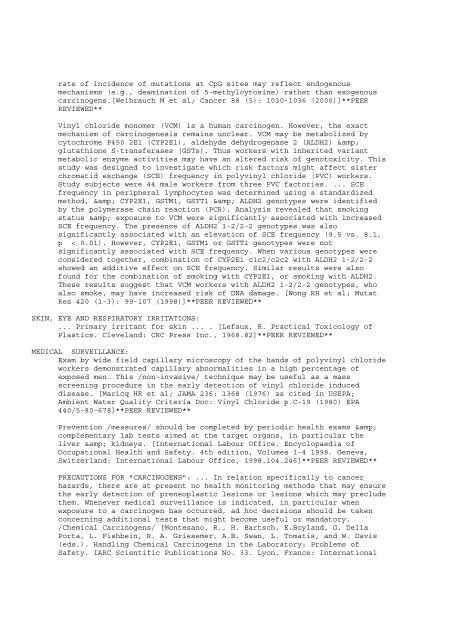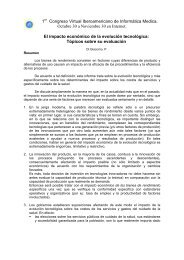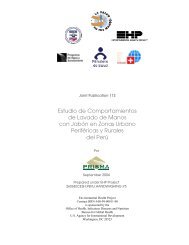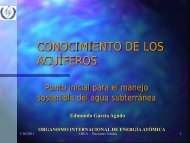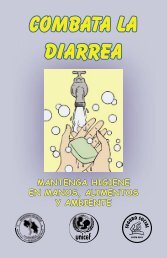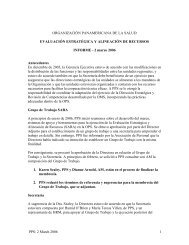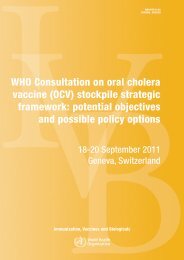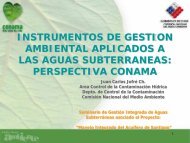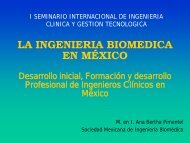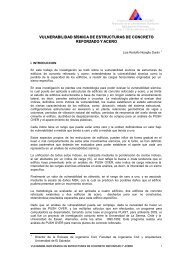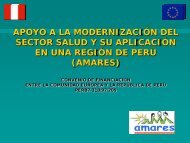a database of the National Library of M
a database of the National Library of M
a database of the National Library of M
You also want an ePaper? Increase the reach of your titles
YUMPU automatically turns print PDFs into web optimized ePapers that Google loves.
ate <strong>of</strong> incidence <strong>of</strong> mutations at CpG sites may reflect endogenousmechanisms (e.g., deamination <strong>of</strong> 5-methylcytosine) ra<strong>the</strong>r than exogenouscarcinogens.[Weihrauch M et al; Cancer 88 (5): 1030-1036 (2000)]**PEERREVIEWED**Vinyl chloride monomer (VCM) is a human carcinogen. However, <strong>the</strong> exactmechanism <strong>of</strong> carcinogenesis remains unclear. VCM may be metabolized bycytochrome P450 2E1 (CYP2E1), aldehyde dehydrogenase 2 (ALDH2) &glutathione S-transferases (GSTs). Thus workers with inherited variantmetabolic enzyme activities may have an altered risk <strong>of</strong> genotoxicity. Thisstudy was designed to investigate which risk factors might affect sisterchromatid exchange (SCE) frequency in polyvinyl chloride (PVC) workers.Study subjects were 44 male workers from three PVC factories. ... SCEfrequency in peripheral lymphocytes was determined using a standardizedmethod, & CYP2E1, GSTM1, GSTT1 & ALDH2 genotypes were identifiedby <strong>the</strong> polymerase chain reaction (PCR). Analysis revealed that smokingstatus & exposure to VCM were significantly associated with increasedSCE frequency. The presence <strong>of</strong> ALDH2 1-2/2-2 genotypes was alsosignificantly associated with an elevation <strong>of</strong> SCE frequency (9.5 vs. 8.1,p < 0.01). However, CYP2E1, GSTM1 or GSTT1 genotypes were notsignificantly associated with SCE frequency. When various genotypes wereconsidered toge<strong>the</strong>r, combination <strong>of</strong> CYP2E1 c1c2/c2c2 with ALDH2 1-2/2-2showed an additive effect on SCE frequency. Similar results were als<strong>of</strong>ound for <strong>the</strong> combination <strong>of</strong> smoking with CYP2E1, or smoking with ALDH2.These results suggest that VCM workers with ALDH2 1-2/2-2 genotypes, whoalso smoke, may have increased risk <strong>of</strong> DNA damage. [Wong RH et al; MutatRes 420 (1-3): 99-107 (1998)]**PEER REVIEWED**SKIN, EYE AND RESPIRATORY IRRITATIONS:... Primary irritant for skin ... . [Lefaux, R. Practical Toxicology <strong>of</strong>Plastics. Cleveland: CRC Press Inc., 1968.82]**PEER REVIEWED**MEDICAL SURVEILLANCE:Exam by wide field capillary microscopy <strong>of</strong> <strong>the</strong> hands <strong>of</strong> polyvinyl chlorideworkers demonstrated capillary abnormalities in a high percentage <strong>of</strong>exposed men. This /non-invasive/ technique may be useful as a massscreening procedure in <strong>the</strong> early detection <strong>of</strong> vinyl chloride induceddisease. [Maricq HR et al; JAMA 236: 1368 (1976) as cited in USEPA;Ambient Water Quality Criteria Doc: Vinyl Chloride p.C-19 (1980) EPA440/5-80-678]**PEER REVIEWED**Prevention /measures/ should be completed by periodic health exams &complementary lab tests aimed at <strong>the</strong> target organs, in particular <strong>the</strong>liver & kidneys. [International Labour Office. Encyclopaedia <strong>of</strong>Occupational Health and Safety. 4th edition, Volumes 1-4 1998. Geneva,Switzerland: International Labour Office, 1998.104.246]**PEER REVIEWED**PRECAUTIONS FOR "CARCINOGENS": ... In relation specifically to cancerhazards, <strong>the</strong>re are at present no health monitoring methods that may ensure<strong>the</strong> early detection <strong>of</strong> preneoplastic lesions or lesions which may preclude<strong>the</strong>m. Whenever medical surveillance is indicated, in particular whenexposure to a carcinogen has occurred, ad hoc decisions should be takenconcerning additional tests that might become useful or mandatory./Chemical Carcinogens/ [Montesano, R., H. Bartsch, E.Boyland, G. DellaPorta, L. Fishbein, R. A. Griesemer, A.B. Swan, L. Tomatis, and W. Davis(eds.). Handling Chemical Carcinogens in <strong>the</strong> Laboratory: Problems <strong>of</strong>Safety. IARC Scientific Publications No. 33. Lyon, France: International


